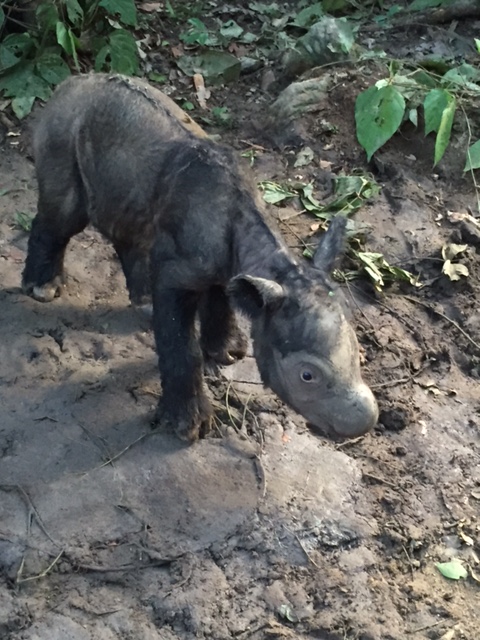It’s a Girl! Sumatran Rhino Birth Gives Species Hope
Rhino from Cincinnati sires second calf in Sumatra!
CINCINNATI (May 12, 2016) – The International Rhino Foundation (IRF) announced today that the critically-endangered Sumatran rhino population has increased by one! A female rhino calf was born on May 12, at 4:42 a.m., at the Sumatran Rhino Sanctuary (SRS) in Indonesia. The calf’s father, Andalas, was born at the Cincinnati Zoo & Botanical Garden in 2001 and moved to the SRS in 2007.
Video of the Birth starts at 1:22 on IRF Facebook Page
With fewer than 100 Sumatran rhinos left on the planet, this birth is significant for the species. “The birth of any healthy Sumatran rhino calf is reason to rejoice, but the birth of a female calf when the species is so very close to extinction, makes this a monumental event. We applaud our Indonesian colleagues on their success and our own Andalas for siring his second calf,” said the scientist who unraveled the mysteries of Sumatran rhino reproduction, Dr. Terri Roth, Director of the Zoo’s Center for Conservation & Research of Endangered Wildlife (CREW). Dr. Roth was at the Sumatran Rhino Sanctuary last winter when Ratu and Andalas were put together for the breeding session that produced this calf!
Cincinnati Zoo keeper Paul Reinhart was in Sumatra this morning for the birth of the calf, along with veterinarians and keepers from the SRS. Reinhart is the only person in the world to have witnessed the births of all five Sumatran rhinos born in zoos in the last century! He was present for the birth of Andalas at the Cincinnati Zoo in 2001, which held the distinction of being the first Sumatran rhino in human care birth in 112 years! CREW’s science-based breeding techniques led to the arrival of a girl, Suci, in 2004 and another boy, Harapan, in 2007. Reinhart cared for all three rhinos.
This is the second calf that Andalas has sired since his arrival at the SRS in 2007. The first calf, a male named Andatu, was born to female Ratu in 2012 and made history as the first Sumatran rhino calf produced in human care in Indonesia.
Reinhart, who arrived in Indonesia in late April and slept by Ratu’s den for the last few nights, texted, “she’s about perfect! Ratu was / is stellar. Sometimes I can’t believe how fortunate I’ve been, to be part of something so extraordinary. It shows how good things can go when people come together.” He will stay at the SRS for a few weeks to assist with the calf and spend some quality time with Andalas and Harapan, the rhino he accompanied from Cincinnati to his new home at the SRS in October, 2015.
Nine-year-old Harapan is thriving at the SRS and will soon get his opportunity to follow in his big brother’s footsteps and contribute to the survival of his species. His departure marked the end of an era for the Cincinnati Zoo’s Sumatran rhino breeding program. Breeding efforts are now concentrated in Indonesia and CREW continues to lend support.
About the Sumatran Rhino Breeding Program at the Cincinnati Zoo
After years of research, CREW scientists at the Cincinnati Zoo, led by Dr. Roth, unraveled the mysteries of Sumatran rhino reproduction and, in 2001, produced Andalas, the first calf bred and born in zoos in 112 years. In 2004, his sister, Suci, was born, and in 2007, Harapan arrived. Between 2001 and 2012, the Cincinnati Zoo held the distinction as the only place successfully breeding this endangered species. The Zoo worked closely with Indonesian and Malaysian colleagues to transfer knowledge and techniques so that they too could succeed. In 2007, the Cincinnati and Los Angeles Zoos agreed to send Andalas to the SRS to replace an old, infertile bull. That sacrifice on the part of the LA Zoo, where Andalas was living at the time of his transfer, paid off in spades in 2012 when Andalas’s healthy son was born in Sumatra.
The Cincinnati Zoo works closely with the Indonesian Ministry of Forestry, the Indonesian Rhino Foundation, the IUCN Asian Rhino Specialist Group and the International Rhino Foundation, to protect this species in the wild and also propagate Sumatran rhinos in human care.
# # #
The world famous Cincinnati Zoo & Botanical Garden opened to the public 140 years ago! It’s been rated the #1 attraction locally and one of the top zoos in the nation by Zagat Survey. It has also been recognized by Child Magazine as one of “The 10 Best Zoos for Kids.” Over 1.5 million people visit the Zoo’s award-winning exhibits, and more than 500 animal and 3000 plant species annually. The Zoo is an accredited member of the Association of Zoos & Aquariums (AZA) and the American Public Gardens Association (APGA), is internationally known for its success in the protection and propagation of endangered animals and plants, and engages in research and conservation projects worldwide.
About CREW – The Center for Conservation and Research of Endangered Wildlife (CREW) at the Cincinnati Zoo & Botanical Garden is a global leader in wildlife conservation. Established in 1991 as the first institution of its kind focused on both plant and animal conservation research, CREW is dedicated to “Saving Species with Science”. World renowned for its accomplishments with its four Signature Projects – endangered rhinoceroses, imperiled small cats, exceptional plants and polar bears – CREW also conducts substantial research with a few select other species. These conservation efforts, involving a diversity of scientific disciplines and multi-institutional collaborations, are expanding our understanding of species biology, enhancing reproduction and genetic management, and ensuring a future for wildlife.

